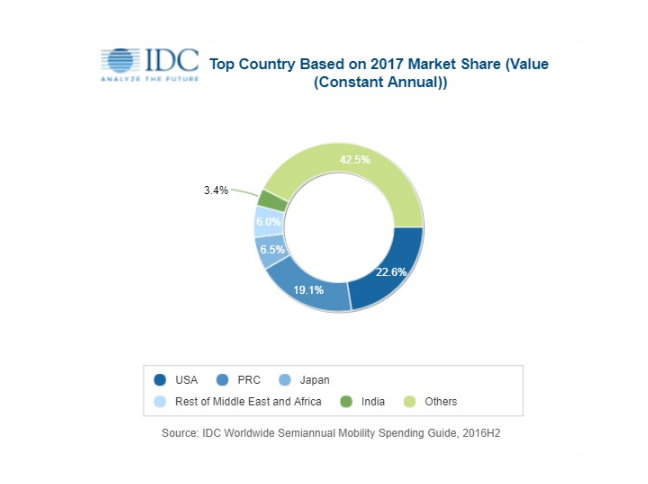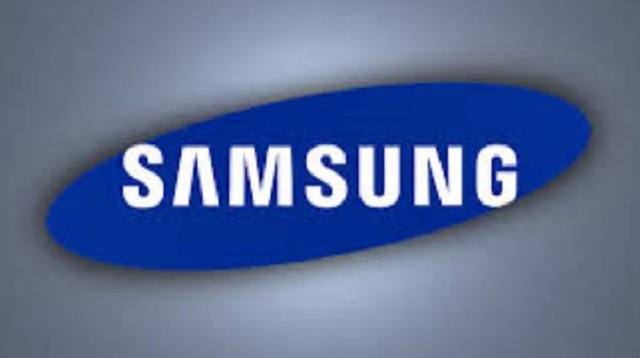Telecom
IDC Forecasts Worldwide Mobility Spending to Reach $1.72Tri in 2021

By peter oluka
Worldwide spending on mobility solutions is forecast to reach $1.72 trillion in 2021, according to the recently updated Worldwide Semiannual Mobility Spending Guide from International Data Corporation (IDC).
Although annual growth is expected to slow over the 2016-2021 forecast period, IDC still expects spending on mobility-related hardware, software, and services to see a five-year compound annual growth rate (CAGR) of 2.7%. Worldwide mobility spending will total $1.58 trillion in 2017, an increase of 4.3% over 2016.
The United States will account for nearly one quarter of all mobility spending throughout the forecast, making it the largest geographic market at nearly $392 billion in 2021. Mainland China will be the second largest country in terms of overall spending ($337 billion in 2021), followed by Japan, Brazil, and the UK.
The countries that will see the fastest growth in mobility spending over the five-year forecast period will be Venezuela (8.2% CAGR), India (8.0% CAGR), Philippines (7.0% CAGR) and Peru (6.7% CAGR).
In contrast, four countries (Australia, Israel, Saudi Arabia, and Taiwan) are forecast to experience a slight decline in mobility spending.
Consumers will provide more than 70% of total mobility spending for all but the last year of the forecast.
Most of this spending will go toward mobile connectivity services and smartphones. In addition to being the largest source of spending, the consumer sector will also experience the slowest growth with a five-year CAGR of 1.3%.
Banking and professional services will be the two industries with the largest mobility spending over the forecast period, reaching $55.1 billion and $54.9 billion in 2021, respectively.
Discrete manufacturing and retail will be close behind with 2021 outlays of $49.7 billion and $45.7 billion.
The industries with the fastest growth in mobility spending will be professional services (7.5% CAGR), construction (7.1% CAGR), and telecommunications (7.0% CAGR). Four other industries (federal/central government, healthcare, retail, and security and investment services) will also outpace the overall market, each with a 6.9% CAGR.
“A highly mobile, on-the-go workforce is a key driver of mobility in both the professional services and construction industries,” said Jessica Goepfert, program director, Customer Insights and Analysis. “User expectations are high within professional services, as they depend on mobile solutions to enable and create exceptional and memorable client interactions and experiences. In construction, which is typically slow to change, we are seeing mobility implementations with the goal of streamlining project administration. In every industry, mobility can provide an advantage over slower-moving competitors by helping firms to complete jobs faster, more efficiently, and with fewer errors.”
The largest technology category will be mobility services, which will account for roughly 60% of all mobility spending throughout the forecast. While mobile connectivity services will be the largest spending segment at $950 billion in 2021, enterprise mobile services will be one of the fastest growing segments with a 15.3% CAGR.
Hardware will be the second largest technology category, led by smartphone purchases. Despite being the smallest category, software represents an important area of investment for enterprises and each of its technology segments (enterprise mobility management, mobile application development platforms, mobile enterprise applications, and mobile enterprise security) will experience double-digit growth throughout the forecast.
“Successful mobilization strategies demand thoughtful integration to broad digitalization strategies and technologies,” said Denise Lund, research director, Enterprise Mobility at IDC. “This means every IT buyer should prioritize vendor solutions that deliver foundational yet flexible and scalable connectivity, security, and device and application management platforms and services. With these qualities, the leverage of today’s and tomorrow’s innovative cloud services will be possible.”
From a company size perspective, small offices with 1 to 9 employees will account for roughly three quarters of all mobility spending worldwide as these businesses purchase mobile devices, connectivity services, and mobility services as an affordable alternative to traditional IT solutions. Very large businesses (1000+ employees) and large businesses (500-999 employees) will deliver the fastest spending growth with five-year CAGRs of 7.8% and 6.9%, respectively.
IDC’s Worldwide Semiannual Mobility Spending Guide is designed to address the needs of technology organizations assessing the mobile opportunity by country, industry, and company size perspective.
The spending guide provides subscribers with spending data on ten technology categories across 19 industries, five company size bands, and 53 countries. Unlike any other research in the industry, the comprehensive spending guide can help IT decision makers to clearly understand the industry-specific scope and direction of mobility spending today and over the next five years.
Telecom
Samsung Plans to Double AI Mobile Devices to 800 million Units this Year

Samsung Electronics plans to double this year the number of its mobile devices with “Galaxy AI” features largely powered by Google’s Gemini, its co-CEO said, which would give the U.S. firm an edge over rivals as the global race in artificial intelligence heats up.

The South Korean company, which had rolled out Gemini-backed AI features to about 400 million mobile products, including smartphones and tablets, by last year, plans to boost that figure to 800 million in 2026.
“We will apply AI to all products, all functions, and all services as quickly as possible,” T M Roh told Reuters in his first interview since becoming Samsung Electronics co-CEO in November.
The plan by the world’s largest backer of Google’s Android mobile platform is set to give a major boost to its developer Google, which is locked in a race with OpenAI and others to attract more consumer users to their AI model.
Samsung seeks to reclaim its lost crown from Apple in the smartphone market and fend off competition from Chinese rivals not only in mobile telephones, but televisions and home appliances, all overseen by Roh.
It will offer integrated AI services across consumer products to widen its lead over Apple in such features, though the latter was set to be the top smartphone maker last year, according to market researcher Counterpoint.
AI Race
Alphabet’s Google launched the latest version of Gemini in November, highlighting Gemini 3’s lead on several popular industry measures of AI model performance.
In response to Gemini 3, OpenAI CEO Sam Altman reportedly issued an internal “code red,” pausing non-core projects and redirecting teams to accelerate development. The ChatGPT maker launched its GPT-5.2 AI model a few weeks later.
Roh expects the adoption of AI to accelerate, as Samsung’s surveys on awareness of its Galaxy AI brand jumped to a level of 80% from about 30% in just one year.
“Even though the AI technology might seem a bit doubtful right now, within six months to a year, these technologies will become more widespread,” he said.
Telecom
MENXTT NG to pre-install Bitdefender Antivirus on all laptops from 2026

MENXTT NG, a leading technology distributor, has announced plans to bundle Bitdefender Antivirus software with all laptops sold in Nigeria starting 2026, aiming to enhance cybersecurity for consumers and businesses.

MENXTT NG
As an authorised reseller of Bitdefender, the company said the initiative would ensure devices meet global security standards right from purchase, addressing rising cyber threats in personal, educational, and corporate sectors.
Bitdefender, a globally recognised antivirus solution, offers advanced threat detection against viruses, malware, ransomware, spyware, and phishing; lightweight performance without impacting device speed; multi-layered ransomware protection; safe browsing features; and certifications from independent testing bodies.
Anthony Emeka Nwosu, Co-Founder of MENXTT NG, stated: “At MENXTT NG, we pride ourselves on offering some of the best laptops, smartphones, and gadgets in the market.
“These devices power businesses, education, and daily life, and it is only right that they are properly protected. By partnering with Bitdefender, we are ensuring our customers enjoy world-class security alongside world-class devices.”
The move, according to industry analysts, positions MENXTT NG as a solutions provider in Nigeria’s tech market, bridging global best practices with local needs amid accelerating digital adoption.
MENXTT NG described the bundling as part of its strategy to deliver complete technology solutions and build customer trust.
For enquiries: +234 814 090 2614; www.menxtt.cm.ng; [email protected].
Telecom
MTN Nigeria Crowns Ayo Benzi Winner of Next Afrobeats Star

MTN Nigeria, in collaboration with ONErpm and Ultima Studios, has announced Ayodeji Benson, popularly known as Ayo Benzi, as the winner of the maiden edition of the Next Afrobeats Star reality show.

L-R: Onyinye Ikenna-Emeka, Chief Marketing Officer, MTN Nigeria; Ayodeji Benson, Winner, Next Afrobeats Star Reality Show (Season 1) and Emamoke Ogoro, General Manager, Brand and Communication, MTN Nigeria, at the grand finale of the Next Afrobeats Star Reality Show (Season 1), held at the Ultima Studios, Lekki, Lagos on Saturday, December 13, 2025.
The grand finale, held on Sunday night at Ultima Studios in Lekki, Lagos, marked the climax of a nationwide talent search that began in September with over 15,000 aspiring musicians.
After weeks of auditions, mentorship, and rigorous training, five finalists – Ayo Benzi, Dave Cash, Kaeko, Somto O’Laker, and Lucky Yay – battled for the top prize in a high-energy showcase of performance and artistry.
At the end of the electrifying contest, Ayo Benzi emerged victorious, securing a ₦150 million music deal. Dave Cash was named first runner-up with ₦100 million, while Kaeko, Somto O’Laker, and Lucky Yay received ₦75 million, ₦50 million, and ₦25 million respectively.
Throughout the season, contestants were mentored by leading Afrobeats producers Sarz, Puffy Tee, P Prime, and Andre Vibez. Benzi, who was part of Puffy Tee’s team, credited the mentorship programme for sharpening his craft and stage presence.
Speaking at the event, Onyinye Ikenna-Emeka, Chief Marketing Officer of MTN Nigeria, said the initiative reflects the company’s commitment to youth empowerment and cultural expression.
“The Next Afrobeats Star platform is about creating real opportunities for young Nigerians and giving their talent the structure, visibility, and support it deserves.
“Afrobeats continues to place Nigeria on the global cultural map, and MTN is proud to be enabling the next generation of artists who will take this sound even further,” she said.
She added that the finale was not just a competition but a celebration of growth and readiness for the global stage.
In his acceptance speech, Ayo Benzi described the victory as a defining moment in his career.
“A big thank you to MTN. From the audition days, the treatment MTN has given us has been amazing. God bless the brand,” he said.
The finale also featured guest performances by Afrobeats stars Iyanya and Bella Shmurda, adding glamour to the night and reinforcing the show’s connection to the wider music ecosystem.
With the successful conclusion of the season, MTN Nigeria and its partners reaffirmed their role in championing youth ambition, supporting creative industries, and shaping the future of Nigerian music through platforms that turn potential into opportunity.

 News2 days ago
News2 days ago974 Nigerians Face Imminent Deportation from Canada Amid Enforcement Surge

 General News2 days ago
General News2 days agoHouse of Reps Releases Certified Copies of Tax Reform Acts amid Gazette Discrepancy Claims

 News13 hours ago
News13 hours agoCourt Sends Faleti, Ex-Lagos Director to Jail for Stealing ₦48.9m from Access Bank

 E-Financial13 hours ago
E-Financial13 hours agoRemita Powers over ₦100 Trillion in Payments as Nigeria’s Digital Economy Expands

 E-Financial13 hours ago
E-Financial13 hours agoWhy 2026 Must Be the Year Nigeria’s Economy Works for All

 E-Financial13 hours ago
E-Financial13 hours agoFlutterwave Acquires Nigeria’s Mono in $25m-$40m All-Stock Deal

 General News13 hours ago
General News13 hours agoNigeria Targets Satellite-to-Mobile Services in Draft Spectrum Roadmap

 E-Financial13 hours ago
E-Financial13 hours ago2026: SEC to Review Rules to Incentivise SME Listings























